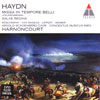Haydn Missa in tempore belli;Salve Regina in G minor
View record and artist detailsRecord and Artist Details
Composer or Director: Joseph Haydn
Label: Das Alte Werk Reference
Magazine Review Date: 13/1997
Media Format: CD or Download
Media Runtime: 58
Mastering:
DDD
Catalogue Number: 0630-13146-2

Tracks:
| Composition | Artist Credit |
|---|---|
| Mass No. 10, 'Missa in tempore belli', 'Paukenmesse' |
Joseph Haydn, Composer
(Arnold) Schoenberg Choir Dorothea Röschmann, Soprano Elisabeth von Magnus, Mezzo soprano Herbert Lippert, Tenor Joseph Haydn, Composer Nikolaus Harnoncourt, Conductor Oliver Widmer, Baritone Vienna Concentus Musicus |
| Salve Regina |
Joseph Haydn, Composer
(Arnold) Schoenberg Choir Dorothea Röschmann, Soprano Elisabeth von Magnus, Mezzo soprano Herbert Lippert, Tenor Joseph Haydn, Composer Nikolaus Harnoncourt, Conductor Oliver Widmer, Baritone Vienna Concentus Musicus |
Author: Richard Wigmore
From the Kyrie’s thunderous first forte, timpani rattling ominously, steely valveless trumpets scything through the texture, Harnoncourt never lets you forget that this is a Mass composed in time of national emergency, with Napoleon’s troops already encamped in Styria. His is an urgent, dramatic, fiercely accented reading, playing up Haydn’s aggressive, brassy sonorities. Moments like the “Pleni sunt coeli” in the Sanctus – an unusually troubled setting of this text – erupt with startling vehemence; the famous Agnus Dei which gives the work its other nickname of “Kettledrum Mass” grows from a hushed, awed opening, with Harnoncourt giving full value to Haydn’s fermate, through a vast crescendo on the repeated cries of “miserere”, underpinned by minatory timpani, to a fearful, trumpet-dominated climax; and more than in any other recording of the Mass, the “Dona nobis pacem”, replete with violent martial fanfares and sharp-edged swordplay from the violins, does not so much ask for peace as insistently, almost desperately, demand it.
As usual Harnoncourt shapes both vocal and instrumental lines with an eye to maximum dramatic and rhetorical effect – one obvious instance is the stabbing, percussive accentuation of the violins’ simple repeated-note accompaniment in the “Crucifixus” (from 3'19''). Here and there I found his phrasing mannered (as at the opening of the Credo, where the choir’s rugged canonic entries are too artfully inflected); and while his tempos are on the wholeshrewdly chosen, balancing breadth with a strong forward momentum, the Allegro moderato of the Kyrie struck me as unduly ponderous in its efforts to banish any hint of levity. Harnoncourt is splendidly served by his orchestra and his responsive, firm-toned choir, though, as so often, the recording favours the orchestra over the chorus. The soloists phrase and balance sensitively in the “Benedictus”, where they and Harnoncourt catch both the music’s gentle dance lilt and its underlying gravity and unease. Oliver Widmer brings a pleasing, well-focused baritone but a lack of true legato to his beautiful solo in the “Qui tollis”.
The rival period recording under Bruno Weil, with an all-male choir, as Haydn would have used, offers a fresh, eager performance, marred by some rough edges and some over-jaunty tempos, notably in the “Qui tollis” (where Harry van der Kamp is a rather raw-toned soloist) and the “Benedictus”. Harnoncourt’s reading, for all its occasional self-consciousness and over-calculation, scores consistently in breadth, intensity and physical power. His performance of the much earlier Salve regina, with its touching chromatic pathos, is likewise the more dramatic and varied in expression. The soloists here are admirable both individually and in ensemble, with notably sweet, gleaming tone from Dorothea Roschmann.'
As usual Harnoncourt shapes both vocal and instrumental lines with an eye to maximum dramatic and rhetorical effect – one obvious instance is the stabbing, percussive accentuation of the violins’ simple repeated-note accompaniment in the “Crucifixus” (from 3'19''). Here and there I found his phrasing mannered (as at the opening of the Credo, where the choir’s rugged canonic entries are too artfully inflected); and while his tempos are on the wholeshrewdly chosen, balancing breadth with a strong forward momentum, the Allegro moderato of the Kyrie struck me as unduly ponderous in its efforts to banish any hint of levity. Harnoncourt is splendidly served by his orchestra and his responsive, firm-toned choir, though, as so often, the recording favours the orchestra over the chorus. The soloists phrase and balance sensitively in the “Benedictus”, where they and Harnoncourt catch both the music’s gentle dance lilt and its underlying gravity and unease. Oliver Widmer brings a pleasing, well-focused baritone but a lack of true legato to his beautiful solo in the “Qui tollis”.
The rival period recording under Bruno Weil, with an all-male choir, as Haydn would have used, offers a fresh, eager performance, marred by some rough edges and some over-jaunty tempos, notably in the “Qui tollis” (where Harry van der Kamp is a rather raw-toned soloist) and the “Benedictus”. Harnoncourt’s reading, for all its occasional self-consciousness and over-calculation, scores consistently in breadth, intensity and physical power. His performance of the much earlier Salve regina, with its touching chromatic pathos, is likewise the more dramatic and varied in expression. The soloists here are admirable both individually and in ensemble, with notably sweet, gleaming tone from Dorothea Roschmann.'
Discover the world's largest classical music catalogue with Presto Music.

Gramophone Digital Club
- Digital Edition
- Digital Archive
- Reviews Database
- Full website access
From £8.75 / month
Subscribe
Gramophone Full Club
- Print Edition
- Digital Edition
- Digital Archive
- Reviews Database
- Full website access
From £11.00 / month
Subscribe
If you are a library, university or other organisation that would be interested in an institutional subscription to Gramophone please click here for further information.




